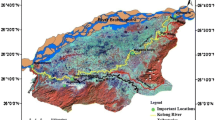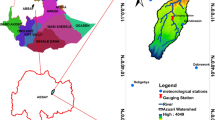Abstract
Water quality of a river is a function of surrounding environment and land use due to its connectivity with land, resulting in pollutants finding their way through land. This necessitates a spatially explicit study of river ecology. The paper presents a pioneer study to establish and explore the linkage between land use and water quality of river Ganga in Varanasi district. The land use land cover (LULC) map of 20 km of river stretch for buffer radii of 1000 m in Varanasi revealed that riparian vegetation is negligible in the district. The hierarchical cluster analysis of LULC data suggested that there are two major land use categories, viz., urban and agriculture. The land use wise principal component analysis (PCA) suggested that urbanized areas are major contributor of metals, whereas agricultural land contributes organic matter into the river. The Spearman correlation study revealed that with rising urbanization, the pollutant load into the river increased compared to that from agricultural land use. The statistical analysis of the data clearly concluded that water quality of river Ganga at Varanasi was a function of adjacent land use. The study provides an insight anticipating the Indian government to embrace the relationship of land use to river water quality while formulating policies for the upcoming River Regulation Zone.






Similar content being viewed by others
References
Allan JD, Erickson DL, Fay J (1997) The influence of catchment land use on stream integrity across multiple spatial scales. Freshw Biol 37(1):149–161
American Public Health Association (APHA), American Water Works Association (AWWA), and Water Environment Federation (WEF) (1995) Standard methods for the examination of water and wastewater 19th edition. United Book Press, Inc., Baltimore, Maryland
Arumugam N, Fatimah MA, Chiew EFC, Zainalabidin M (2010) Supply chain analysis of fresh fruits and vegetables (FFV): prospects of contract farming. Agr Econ 56(9):435–442
Barnes RT, Raymond PA (2009) The contribution of agricultural and urban activities to inorganic carbon fluxes within temperate watersheds. Chem Geol 266(3):318–327
Bhardwaj V, Singh DS, Singh AK (2010) Water quality of the Chhoti Gandak River using principal component analysis, Ganga plain, India. J Earth Syst Sc 119(1):117–127
Bu H, Meng W, Zhang Y, Wan J (2014) Relationships between land use patterns and water quality in the Taizi River basin, China. Ecol Indic 41:187–197
Chattopadhyay S, Rani LA, Sangeetha PV (2005) Water quality variations as linked to landuse pattern: a case study in Chalakudy river basin, Kerala. Curr Sci 89(12):2163–2189
Duan W, He B, Takara K, Luo P, Nover D, Sahu N, Yamashiki Y (2013a) Spatiotemporal evaluation of water quality incidents in Japan between 1996 and 2007. Chemosphere 93(6):946–953
Duan W, Takara K, He B, Luo PP, Nover D, Yamashiki Y (2013b) Spatial and temporal trends in estimates of nutrient and suspended sediment loads in the Ishikari River, Japan, 1985 to 2010. Sci Total Environ 461:499–508
Duan W, He B, Takara K, Luo PP, Nover D, Hu MC (2015) Modeling suspended sediment sources and transport in the Ishikari River basin, Japan, using SPARROW. Hydrol Earth Syst Sc 19(3):1293–1306
Duan W, He B, Nover D, Yang G, Chen W, Meng H, Liu C (2016) Water quality assessment and pollution source identification of the eastern Poyang Lake Basin using multivariate statistical methods. Sustainability 8(2):1–15
Ekness P (2013) Ecohydrological impacts of climate and land use changes on watershed systems: a multi-scale assessment for policy. Dissertation, University of Massachusetts, Amherst Scholar Works @ UMass Amherst, paper 789
Giri N, Singh OP (2013) Urban growth and water quality in Thimphu, Bhutan. J Urban Environ Eng 7(1):82–95
Griffith JA (2002) Geographic techniques and recent applications of remote sensing to landscape-water quality studies. Water Air Soil Poll 138(1–4):181–197
Hashmi F (2013) Correlation between riparian buffers and water quality in North Carolina watersheds. Doctoral dissertation, Duke University
Hayashi M (2004) Temperature-electrical conductivity relation of water for environmental monitoring and geophysical data inversion. Environ Monit Assess 96(1–3):119–128
Huang F, Wang X, Lou L, Zhou Z, Wu J (2010) Spatial variation and source apportionment of water pollution in Qiantang River (China) using statistical techniques. Water Res 44(5):1562–1572
Huang J, Zhan J, Yan H, Wu F, Deng X (2013) Evaluation of the impacts of land use on water quality: a case study in the Chaohu lake basin. Sci World J 2013:1–7
Ierodiaconou D, Laurenson L, Leblanc M, Stagnitti F, Duff G, Salzman S, Versace V (2005) The consequences of land use change on nutrient exports: a regional scale assessment in south-West Victoria, Australia. J Environ Manag 74(4):305–316
Indian Council of Agricultural Research (ICAR) (2009) A Science and Technology Newsletter 15(2). www.icar.org.in
Iwashita M, Shimamura T (2003) Long-term variations in dissolved trace elements in the Sagami River and its tributaries (upstream area), Japan. Sci Total Environ 312(1):167–179
Jackson DA (1993) Stopping rules in principal components analysis: a comparison of heuristical and statistical approaches. Ecology 74(8):2204–2214
Jaiswal JK, Verma N (2013) Land use change detection in Baragaon block, Varanasi District using remote sensing. Int J Eng Sci Innov 2(7):49–53
Juahir H, Zain SM, Yusoff MK, Hanidza TT, Armi AM, Toriman ME, Mokhtar M (2011) Spatial water quality assessment of Langat River basin (Malaysia) using environmetric techniques. Environ Monit Assess 173(1–4):625–641
Kaiser HF (1974) An index of factorial simplicity. Psychometrika 39(1):31–36
Kumari M, Tripathi BD (2014) Source apportionment of wastewater pollutants using multivariate analyses. B Environ Contam Tox 93(1):19–24
Lattin JM, Carroll JD, Green PE (2003) Analyzing multivariate data. Thomson Brooks/Cole, Pacific Grove, CA
Liu CW, Lin KH, Kuo YM (2003) Application of factor analysis in the assessment of groundwater quality in a Blackfoot disease area in Taiwan. Sci Total Environ 313(1):77–89
Manage AB, Scariano SM (2013) An introductory application of principal components to cricket data. J Stat Educ 21(3):1–22
McDonald JH (2009) Handbook of biological statistics. Sparky House Publishing, Baltimore, MD
Mckenna J (2003) An enhanced cluster analysis program with bootstrap significance testing for ecological community analysis. Environ Model Softw 18(3):205–220
Mishra A (2010) Assessment of water quality using principal component analysis: a case study of the river Ganges. J Water Chem Techno 32(4):227–234
Mooi E, Sarstedt M (2011) A concise guide to market research—the process, data and methods using IBM SPSS statistics. Springer, Heidelberg Dordrecht, London
Mustapha A, Abdu A (2012) Application of principal component analysis & multiple regression models in surface water quality assessment. J Environ Earth Sci 2(2):16–23
National Remote Sensing Agency (NRSA) (2005) National Resources census, Department of Space, Government of India
National River Conservation Directorate, Ministry of Environment and Forests, Government of India (2009) Status paper on River Ganga—state of environment and water quality. Report, Alternate Hydro Energy Centre, Indian Institute of Technology, Roorkee 1–31
Ohri A, Poonam (2012) Urban sprawl mapping and land use change detection using remote sensing and GIS. International Journal of Remote Sensing and GIS 1(1):12–25
Osborne JW (2015) What is rotating in exploratory factor analysis? Pract Assess Res Eval 20(2):1–7
Ouyang Y (2005) Evaluation of river water quality monitoring stations by principal component analysis. Water Res 39(12):2621–2635
Papafilippaki AK, Kotti ME, Stavroulakis GG (2008) Seasonal variations in dissolved heavy metals in the Keritis River, Chania, Greece. Global nest. The Int J 10(3):320–325
Perry J, Vanderklein E (1996) Water quality management of a natural resource. Blackwell Science, Cambridge, Massachusetts, pp 639
Poor CJ, McDonnell JJ (2007) The effects of land use on stream nitrate dynamics. J Hydrol 332(1):54–68
Prasad R (2007) Phosphorus management in the rice-wheat cropping system of the Indo-Gangetic plains. Better Crops–India:8–11
Raj PN, Azeez PA (2010) Land use and land cover changes in a tropical river basin: a case from Bharathapuzha River basin, southern India. J Geogr Inf Sys 2(04):185
Ravindra K, Ameena M, Monika R, Kaushik A (2003) Seasonal variations in physico-chemical characteristics of river Yamuna in Haryana and its ecological best-designated use. J Environ Monitor 5(3):419–426
Ren W, Zhong Y, Meligrana J, Anderson B, Watt WE, Chen J, Leung HL (2003) Urbanization, land use, and water quality in Shanghai: 1947–1996. Environ Int 29(5):649–659
Rothwell JJ, Dise NB, Taylor KG, Allott TEH, Scholefield P, Davies H, Neal C (2010) Predicting river water quality across north West England using catchment characteristics. J Hydrol 395(3):153–162
Sharma S, Agrawal M (2014) Thwarting changing land use—a step towards Ganga rejuvenation. Curr Sci 107(2):174
Shlens J (2014) A tutorial on principal component analysis. arXiv preprint arXiv:1404.1100
Shrestha S, Kazama F (2007) Assessment of surface water quality using multivariate statistical techniques: a case study of the Fuji river basin, Japan. Environ Model Softw 22(4):464–475
Simeonov V, Stratis JA, Samara C, Zachariadis G, Voutsa A, Anthemidis SM, Kouimtzis T (2003) Assessment of the surface water quality in northern Greece. Water Res 37(17):4119–4124
Singh KP, Malik A, Mohan D, Sinha S (2004) Multivariate statistical techniques for the evaluation of spatial and temporal variations in water quality of Gomti River (India)—a case study. Water Res 38(18):3980–3992
Singh RP (2004) Cultural landscapes and the lifeworld: literary images of Banaras. Pilgrimage and cosmology. Indica Book, Varanasi
Singh KP, Malik A, Sinha S (2005) Water quality assessment and apportionment of pollution sources of Gomti river (India) using multivariate statistical techniques—a case study. Anal Chim Acta 538(1):355–374
Sliva L, Williams DD (2001) Buffer zone versus whole catchment approaches to studying land use impact on river water quality. Water Res 35(14):3462–3472
Soman K, Mahamaya C, Ouseph PP (1997) Status of riverine pollution in south Kerala and its relation to physiography and landuse. In Proc. IX Kerala Science Congress, Thiruvananthapuram, pp 93–95
Stets EG, Kelly VJ, Crawford CG (2014) Long-term trends in alkalinity in large rivers of the conterminous US in relation to acidification, agriculture, and hydrologic modification. Sci Total Environ 488:280–289
Strobl RO, Robillard PD (2008) Network design for water quality monitoring of surface freshwaters: a review. J Environ Manag 87(4):639–648
Tiwari TN, Ali (1988) Water quality index for Indian rivers. In: Trivedy RK (ed) Ecology and pollution of Indian rivers, 1st edn. Ashish Publishing House, New Delhi, pp. 271–286
Umamaheswari S, Saravanan NA (2009) Water quality of Cauvery River basin in Trichirappalli, India. International Journal of Lakes and Rivers 2(1):1–10
Varol M, Gökot B, Bekleyen A, Şen B (2012) Water quality assessment and apportionment of pollution sources of Tigris River (Turkey) using multivariate statistical techniques—a case study. River Res Appl 28(9):1428–1438
Vega M, Pardo R, Barrado E, Debán L (1998) Assessment of seasonal and polluting effects on the quality of river water by exploratory data analysis. Water Res 32(12):3581–3592
Ward JV (1989) The four-dimensional nature of lotic ecosystems. J N Am Benthol Soc 8(1):2–8
Ward JH Jr (1963) Hierarchical grouping to optimize an objective function. J Amer Statist Assoc 58(301):236–244
Yaari Y (1997) Segmentation of expository texts by hierarchical agglomerative clustering. arXiv preprint cmp-lg/9709015
Zhang Q, Xu CY, Tao H, Jiang T, Chen YD (2010) Climate changes and their impacts on water resources in the arid regions: a case study of the Tarim River basin, China. Stoch Env Res Risk A 24(3):349–358
Zheng PQ, Baetz BW (1999) GIS-based analysis of development options from a hydrology perspective. J Urban Plan D 125(4):164–180
http://varanasi.nic.in/. Accessed date 31 Dec 2015
http://www.varanasi.org.in/. Accessed date 2 Jan 2016
http://www.businesstoday.in/. Accessed date 1 Jun 2016
http://india-wris.nrsc.gov.in/. Accessed date 1 Jun 2016
Acknowledgments
The authors are thankful to the Head of the Department of Botany, Banaras Hindu University and Director of the Indian Institute of Remote Sensing for providing necessary facilities to carry out the research work. The DST-INSPIRE fellowship, Government of India is also acknowledged for financial support. The authors also acknowledge the anonymous reviewers for their valuable comments and suggestions which helped in improving the manuscript.
Author information
Authors and Affiliations
Corresponding author
Additional information
Responsible editor: Philippe Garrigues
Electronic supplementary material
Supplementary Table 1
(DOCX 19 kb)
Supplementary Table 2
(DOCX 21 kb)
Supplementary Table 3
(DOCX 21 kb)
Supplementary Table 4
(DOCX 21 kb)
Supplementary Table 5
(DOCX 22 kb)
Rights and permissions
About this article
Cite this article
Sharma, S., Roy, A. & Agrawal, M. Spatial variations in water quality of river Ganga with respect to land uses in Varanasi. Environ Sci Pollut Res 23, 21872–21882 (2016). https://doi.org/10.1007/s11356-016-7411-9
Received:
Accepted:
Published:
Issue Date:
DOI: https://doi.org/10.1007/s11356-016-7411-9




